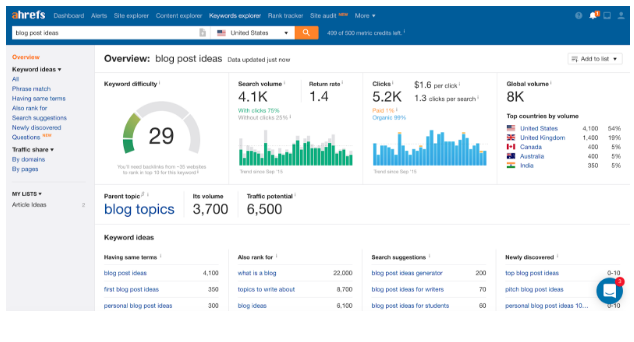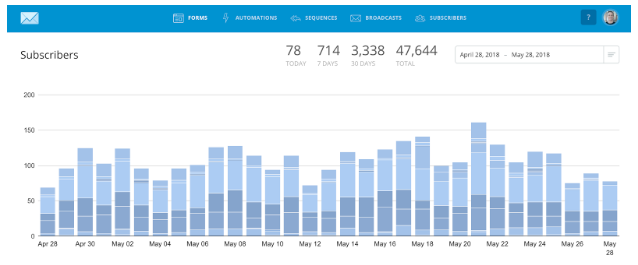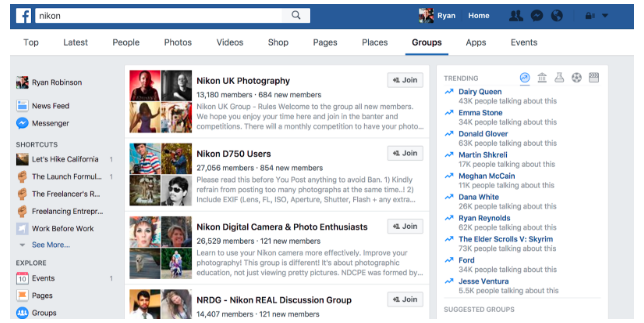A couple of weeks ago, we covered the mechanics of building a blog (the right way), how to pick a winning niche for your content topics, which CMS you should choose for long-term growth of your blog, and finding a winning domain name.
I’m a firm believer that it’s important to not only explain how to get your blog up and running, but to also look at ways to grow it into something you’re proud of—and something that can actually earn you a meaningful amount of income.
Over the past few years, I’ve grown my blog from a small side project into a profitable site that brings in millions of readers a year. I’ve been lucky enough to work for some fantastic companies and get paid to learn about the importance of having a blog content strategy. I’ve successfully applied those same lessons to my own blog, and that’s exactly what we’re going to cover here today.
Here’s how to put a clear content strategy together:
- Define the goal for your blog
What do you want to achieve with your blog content? Is it to drive traffic and get readers? To get people to sign up for your email newsletter? To get them to download a book you wrote or some other resource? To generate leads for a product you’re selling?
This goal might change as you start to build your blog, but it’s still important to know it early on. As prolific blogger and marketing guru, Seth Godin, explains:
“You have the freedom to make these choices at the beginning when they’re free, fast and easy. Not later on when you’ve made commitments.”
Once you understand your greater goal for building a blog and have a clearly defined purpose for dedicating many hours to this pursuit in the coming months, we can start to define the smaller wins that will help you get there.
- Get to know your readers (and where they spend time)
Your readers determine whether or not your blog is successful. And to write for them, you need to really understand them, which is why it helps if you’re also writing for yourself. This guarantees at least an audience of one.
In a lot of cases, you’re going to be your ideal reader, which makes this whole process easier. But in almost every case, it’s useful to do a bit of research around the audience you’re writing for (heck, you might even learn something about yourself!).
To start, you want to think about the demographics and psychographics of your ideal audience:
- Demographics: The quantitative traits of your readers. Think: age, gender, location, job title, etc…
- Psychographics: The more “unmeasurable” traits like values, interests, attitude and belief systems.
Once you’ve written down these qualities, you can start to come up with an audience persona, or a fictionalized version of your ideal reader.
Related: The Mechanics of Building a Successful Blog (With Over 2 Million Readers) on the Side
- Decide on your content pillars
When it comes to actually deciding what you’re going to write about, it’s good to have a few guiding topics that you refer back to. I like to call these content pillars, as they’re the foundation that holds up the rest of your blog.
Having a few set pillars like this helps keep your blog focused. It also gives you a lense and a voice that you can write from.
- Brainstorm blog post ideas and use keyword research

This is where I believe a simple editorial calendar is so important. This is just a basic doc to fill out that means you’ll always know what you’re writing next and frees you up to spend more time on the fun of actually putting posts together.
Here’s a simple process I use for coming up with the specific posts to write about:
- Brainstorm topics/terms and write them all down: Start by writing down as many ideas or keywords that you can. Aim for things you know your ideal audience would find valuable. What questions are they asking? Where do you have expertise and where can you help fill in the blanks?
- Use a keyword research tool to gather even more ideas: We want a TON of these blog post topics, so let’s use a keyword explorer tool like Ahrefs (pictured above) or Moz to help us fill it out. These tools basically just show you terms and topics related to the ones you’ve already come up with, as well as how much traffic those terms are getting (to show that your audience cares about them).
- Clump similar ideas together: Your list should be pretty huge at this point. So take all those terms and start to refine them. Are there duplicates that you can lump together? Do some just not look right now? Refine and edit it down.
- Put your ideas in a spreadsheet and prioritize: OK, let’s get this list a little more organized now. Start a spreadsheet (or use a project management tool to organize) and include your keyword, estimated search volume, difficulty and opportunity. You should be able to get all this information from the keyword tool you use. Looking at all these, assign a priority to each one, either on a scale of one to five, or a basic high-medium-low scale.
- Outline content that hits all three key needs: Take your top priorities and set deadlines for them. Look for topics that hit all three key needs: Fits your content pillars, are genuine needs of your readers and have some traffic potential.
Publish, promote and drive traffic to your posts
There’s one last piece of the puzzle that hardly any other bloggers openly talk about: content promotion.
What do you do once you’ve hit publish?
It’s a question I hear time and time again, and it’s one that separates the great blogs from the ones that are only read by your mom and a few spam bots. If you’re looking to drive traffic and build a successful business from your blog, you need to know how to promote your posts.
Here are a few of the best ways to start sharing your posts and getting in front of new readers.
Social media
The obvious first place to turn to is social media. Facebook, Twitter, Pinterest, LinkedIn, Reddit, Instagram, Snapchat, the list goes on. Whichever platform best suits your niche and your audience is the right one for you.
There’s no point in trying to promote your blog posts on every social media platform in existence. Instead, look for the ones that give you the best return. The key thing here is to experiment and see what works for you.
Each social network naturally appeals to a certain niche and a certain type of reader. This is a pretty broad statement, but generally speaking, here’s what works best on each social platform:
- Facebook: Videos and curated content
- Instagram: High-res photos, quotes and Stories
- Twitter: News, blog posts and GIFs
- LinkedIn: Professional content and career news
- Pinterest: Infographics, step-by-step photo guides, visual content
- Google+: Blog posts you want to rank well on Google
- Reddit: Comments about topics in your niche
It’s a lot, but luckily there are a plethora of tools that can help you manage your social media posts throughout the week. In fact, with the right tool, you should be able to promote all your posts across social in just an hour or two a week.
Here are my favorites:
- Buffer: One of the easiest ways to schedule social shares in advance for Facebook, Instagram, Twitter, LinkedIn, Pinterest and Google+. The browser plug-in is also great for quickly adding interesting posts you find to your social promotion queue.
- Hootsuite: If you want something a bit more in-depth, Hootsuite is a powerful social sharing, scheduling and monitoring platform. It’s probably a bit too much for a beginner blogger, but is a worthwhile option to check out once you start to grow.
- Gain App: If you work with multiple people on your blog, Gain is a great tool for collaborating and controlling who posts what from your account. It’s a bit more expensive, but their workflows can save you a ton of time.
Forums and message boards
Sometimes just throwing your ideas out into the social media void isn’t worth it. Instead, being a part of targeted forums and online communities can give you a way better return on your time, and is a much better time investment if you’re still developing your idea and perfecting the message of your blog.
Look for a topically relevant group to join. For example, if you’re starting a blog about photography, you could consider joining Facebook groups like Nikon Digital Camera & Photo Enthusiasts (26,000 plus members), Nikon D750 Users (27,000 plus members) and Nikon UK Photography (13,000 plus members).
If your blog is relevant to anyone with a DSLR camera, you’re sure to find enough people who’d be interested in reading your posts within those groups. Now, if your search doesn’t come up with any Facebook Groups with a decent number of members (5,000 or more) there are some other options. Look for general Facebook Groups that relate to your niche or groups on LinkedIn or Reddit.
Remember though, these aren’t just places to dump links to your blog posts. You need to provide value before you ask for anything in return. So, start by building relationships and engaging with people there.
You never know, you might come up with some great blog ideas in the process.
Guest posts and blogging on sites like Medium, Quora, Linkedin and others
One of the best things about building a blog is that bloggers love to help each other out. Guest posting on other relevant blogs is one of the best ways to connect with an already established audience.
As Laurence Bradford of Learn to Code with Me told me in her podcast interview:
“When I first started my blog, I started guest posting really early on. I’d make spreadsheets and reach out to editors and other bloggers. It definitely took a while to gain traction. I went through a lot of rejection, but over time it became easier because I’d built this portfolio of other things I published.”
Laurence started by going after smaller coding blogs and sites with a similar audience to the one she wanted to build. It might seem like a lot of work, but those early guest posts are what helped her build her own audience and community. Eventually, as her network grew, she was able to make better connections and start posting on bigger blogs.
For starters, try reposting your blog posts on Medium, a site that’s free to use for readers and writers. You can even look for a Medium Publication that’s popular in your niche and submit your post.
There’s also Quora, a question and answer site that lets anyone respond to users’ queries. One tactic I’ve used is to search for relevant topics in my niche and then answer questions I’ve already written about on my blog. This way, I know I’m providing good value and can even link back to the full post on my blog.
Lastly, if you’re more business-oriented in your blog posts, you might want to post them on LinkedIn. The key point to all of this is that you want to look for places where your audience is and be there. Whether that’s other blogs, communities or social platforms.
Sign Up: Receive the StartupNation newsletter!
Using an email newsletter to grow your audience

Other ways to grow your blog’s traffic
Outside of promotion on social media, email marketing and guest posts, there are a few other techniques I’ve regularly used to grow my blog audience:
- Interview people in your niche: There’s nothing better than learning from famous people in your niche. Not only does interviewing them help you build a relationship, but other people reading your blog want to hear from them. You can use these interviews for blog posts or even start a podcast like I did with The Side Hustle Project.
- Network with other bloggers or mention their blogs: Early on, you want to get on other people’s radars. One of the best ways to do so is to mention other relevant bloggers and blog posts on yours. For Austin Belcak, founder of Cultivated Culture, that meant linking out to relevant blog posts and then emailing the blogger and saying “Hey! I mentioned you in my most recent article. If you think it’s worthy of a share, I’d really appreciate it. But if not, I’m happy to keep sharing yours.” This drove the initial 50,000 readers of his blog to 60,000.
- Talk to people about what you’re doing: It might seem too simple, but tell the people around you what you’re doing. Get excited about your blog and share the things you’re working on. As Gaby Dalkin of What’s Gaby Cooking told me, “Maybe it’s just your friends reading you to start, but you should be responding to every comment and going out and commenting on other blogs. This is essentially your industry and these are your co-workers.”
- Learn from other top bloggers: If you don’t feel ready to connect with other bloggers in your space, at least try to learn from what they’re doing. Silas Moser, one half of Chasing Foxes, told me you should study people who are good at what you’re doing: “Look at what works for them and see how you can use it. So many people told us ‘you could never make money from a blog.’ But you don’t have to reinvent the wheel. There are tons of successful bloggers out there that you can learn from and see what they’ve done and apply that to your niche.”
What this all boils down to is being excited and engaging with your content. If you want people to read what you’re writing, you need to give them a reason to. Write exciting content, connect with people in the space and enthusiastically share what you’re working on. The rest will follow.







